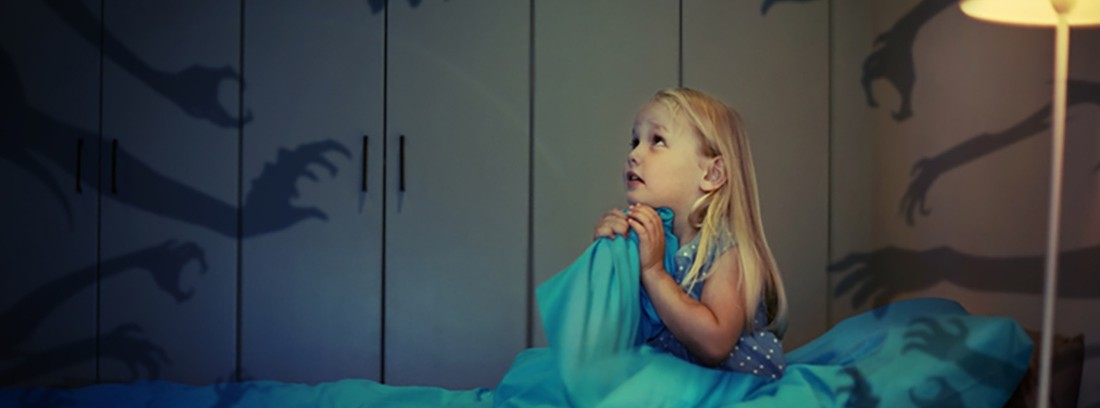Nightmares and night terrors

What are nightmares?
These are terrifying or distressing dreams after which the child wakes up, scared but oriented. When the parents come, the child recognizes them and is also able to remember and relate coherently the dream he has had. Nightmares occur in the so-called REM sleep and they generally take place during the second half of the night. They usually appear from 2 or 3 years old and they are usually related to phenomena that cause concern in the child, such as dramatic or traumatic scenes seen on television. They can also be the result of certain insecurities, anxiety, fear or worries in the child's life.
Although they often worry parents, nightmares are part of the normal development of a child when they occur between the ages of 2 and 6. The duration of these can be several weeks and usually decrease as the phenomenon that causes anxiety lessens or disappears. In cases where nightmares occur very frequently and, especially if the child is 7 years or older, it is advisable for an assessment to be carried out.
Tips for parents
Some recommendations to keep in mind to reduce the incidence of nightmares or to prevent them from appearing are:
- Know the concerns of the child, for example, at school, at home or with friends.
- Discuss them carefully with him and help him solve them.
- Avoid exposing the child to certain anxious stimuli before going to bed, such as watching movies or listening to scary stories, or doing violent physical exercises.
- When the child wakes up to a nightmare, parents should go to his room in order to reassure him and give him security. Once achieved, it is advisable to leave his room, allowing him to go back to sleep alone.
- It may also be helpful to caress and rock the child, without placing too much importance on the nightmare, as the child may learn to use it as a mechanism to attract attention on later occasions. A good time to talk about the content of the dream is during the day, with the aim of detecting the problem or concern behind it and helping you to solve it.
- Avoid excessive excitement. Children should have a period of calm and relaxation before going to bed.
Night terrors
Night terrors, on the other hand, are terrifying dreams after which the child does not wake up. They are characterized by screaming, crying, sudden movements, sweating, and tachycardia.
In many cases, the child sits up, and although he opens his eyes, he is not really awake. He does not recognize his parents when they come to calm him down and does not calm down no matter how hard they try, since he does not perceive reassuring words or gestures. These types of dreams can last up to approximately 10 minutes and, when the episode ends, the child continues to sleep normally. It is common not to remember anything of what happened when waking up.
Night terrors are believed to reflect immature stages of sleep, in which the child has difficulty making the transition from the deepest state of sleep to the most superficial. Unlike nightmares, they occur in the non-REM sleep and they usually appear during the first half of the night. They also usually occur around 2 or 3 years of age and stop spontaneously.
Recommendations for parents
There is little that can be done to help the child during a night terror, since one must simply wait for it to stop. In spite of everything, there are some recommendations that should be taken into account to reduce the incidence of night terrors or to prevent them from appearing:
- Reassure and calm the child, for example, with hugs. It must be borne in mind that if the child wakes up he will not remember anything of what happened.
- Regulate the child's sleep schedules, making sure they get enough rest. Children with an inappropriate habit are more likely to suffer from night terrors than those with an adequate habit.
- Consult with a professional. Although night terrors are not generally significant, there is a possibility that they are symptoms of neurological disorders. Likewise, it is also advisable to consult a specialist in case the disorder lasts a long time.
- If your child is very tired at bedtime, it can increase the likelihood of night terrors. For this reason, it is advisable to put him to bed prior to this state of fatigue: the child must fall asleep in a calm and fearless way.
- They coincide in ... they are terrifying and distressing dreams.
- They differ in ... after nightmares the child wakes up, scared but oriented, and in night terrors he does not wake up.
- Consult a specialist ... in the case of night terrors to rule out neurological disorders.
Elena Killed Specialist in Clinical Psychology
(Updated at Apr 14 / 2024)